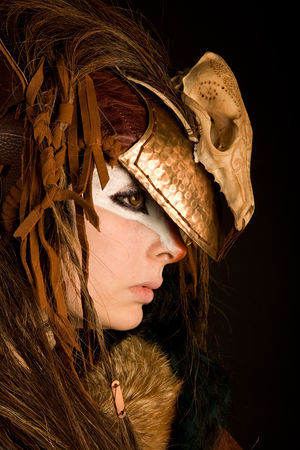Spellcasting
(→Staff) |
|||
| Line 92: | Line 92: | ||
The items must be substantial and cover a significant portion of the area but it is possible to use a single pauldron, greave or vambrace if appropriate for the costume. | The items must be substantial and cover a significant portion of the area but it is possible to use a single pauldron, greave or vambrace if appropriate for the costume. | ||
Although mage armour is magical in nature, if you have purchased | Although mage armour is magical in nature, if you have purchased the [[Magical_skills#Battle_Mage|Battle Mage]] skill then you are considered to have access to a suit of mage armour, in the same way a warrior has access to a suit of mundane armour. | ||
Mage armour can be made out of any real world material, provided you try to make as clear as possible that your character is wearing magical protection and not mundane armour. | Mage armour can be made out of any real world material, provided you try to make as clear as possible that your character is wearing magical protection and not mundane armour. | ||
<span id="Contributors"></span> | <span id="Contributors"></span> | ||
==Rituals== | ==Rituals== | ||
{{RulesRituals}} | {{RulesRituals}} | ||
Revision as of 13:47, 29 March 2014
Magic Calls
- There are six magic calls
- The magic calls do not affect targets that are larger than human-sized
- All magic calls delivered with a weapon or implement also cause the target to lose one global hit
- The MASS call when combined with another magic call expands the range to a 20' cone from the caster
There are six magic calls that can affect you. All players should make sure that they are familiar with these calls and their effects.
There is no way to resist a magic call in Empire, but magic calls never affect any creature that is larger than human-sized. Any monstrous creature whose phys-rep is expressly designed to make them taller or wider than the wearer would normally be counts as larger than human-sized. Player-characters (all PCs) always count as human-sized - no matter how large the player is.
CURSE
- You are cursed; see a ref for details when it is appropriate to do so
- The effect lasts until cured
A curse does not immediately affect your character; you are aware that you have been cursed but may continue to fight and act normally. See a referee for more details once you are able to do so without interrupting your roleplaying.
ENTANGLE
- The target may not move their feet; they may otherwise move and fight normally
- The effect lasts 10 seconds
PARALYSE
- The target may talk but may not make any other movement
- The effect lasts 10 seconds
REPEL
- The target must move away from the caster at a brisk walk or faster
- The effect lasts 10 seconds or until you have retreated for 20’
VENOM
- The target’s bleed time drops to zero; they become Terminal immediately if they lose all body hits (and may not use the unstoppable ability)
- The effect lasts until cured
WEAKNESS
- The target may not use any heroic skills, utilize any Enchantments, use any mana or activate any magic items; they may otherwise move and fight normally
- The effect lasts until cured
MASS
- MASS is an area effect call that expands the range of other calls to a 20' cone (maximum 90 degrees) from the caster. It is commonly caused by rituals, though there are unnatural creatures in the world that can cause MASS effects.
Spellcasting
- You must expend personal mana or crystalized mana to cast a spell
- Every magician starts with four personal mana every day
- You cannot cast spells while wearing armour
- All spells require vocals clearly audible to everyone within a few metres
Any character that purchases the magician skill has four personal mana and is able to cast create bond, detect magic or operate portal. Each time a character purchases an extra spell they must choose one additional spell from the spell list.
Your character may also use crystalized mana to cast spells; a single crystal can be used to cast any single spell.
Your personal mana replenishes overnight.
All spell vocals require appropriate roleplaying which must include spell vocals in a clear voice audible to everyone within a few metres of you.
Implements
- Offensive spells can only be delivered using an implement
- Must be a safe phys-rep of a wand, rod or staff
- Should not look like a weapon
An implement is a magical tool that allows a magician to briefly store the effect of an offensive spell before it is released. All offensive spells require an implement to be used. You cannot use an implement to change the casting time or extend the range of regular spells such as mend or heal.
All magical implements must be weapon safe phys-reps. They may appear to be made of any material, and should be decorated and shaped to make it as clear as possible that they are magical implements and not weapons.
Implements come in three broad classifications; wands, rods and staves. Any character with the magician skill can wield a wand or rod effectively, but the wield mage staff skill is needed to wield a staff.
A character can cause a point of damage with an implement, but they cannot be used with the heroic skills cleaving strike, shattering blow or mighty strikedown.
Although any magician may choose to use a wand or rod as an implement, some magical enchantments can only be placed on wands and some can only be placed on rods.
Wands
A wand is 8” to 18” long. Magical wands usually enhance healing incantations such as restore limb or utility incantations such as mend
Rods
A rod is 18” to 42” long. Wielded in one hand, a rod is popular with many magicians who take the battlefield because it can be combined with a shield or with another one-handed weapon (provided the magician possesses the skill to do so). Magical rods most commonly enhance battlefield incantations such as repel or swift heal.
Staff
A staff is 42” to 84” long. It must be wielded in two hands, but greatly extends the magicians reach for delivering implement incantations. Staves are popular with magicians of all backgrounds, but require the Battle Mage skill to use in battle. Magic staves may enhance battlefield incantation or grant benefits to ritual casters.
Mage Armour
- Must cover at least 3 locations including one of the chest, shoulders or waist
- Providers 2 extra hits only
- Does not protect against CLEAVE or IMPALE calls
Mage armour is a magical talisman that protects you against harm but allows you to cast spells. The talisman is made up of several pieces fitted to the wearer's body to protect them. The parts of the talisman superficially resemble pieces of armour, but armour that is ornate and ceremonial rather than practical. They are often decorated with runes, crystals, gems or other magical accoutrements and it is clear that the armour protects the wearer through magic rather than by physically deflecting blows.
Mage armour provides the wearer with two additional hits. Mage armour does not protect against CLEAVE or IMPALE. To qualify the talisman must include three of the following items including at least one of the first three items on the list:
- Pauldrons (shoulders)
- Pectorals (upper chest)
- Hero Belt (waist)
- Circlet (head)
- Vambraces (wrists)
- Gorget (neck)
- Greaves (lower legs)
The items must be substantial and cover a significant portion of the area but it is possible to use a single pauldron, greave or vambrace if appropriate for the costume.
Although mage armour is magical in nature, if you have purchased the Battle Mage skill then you are considered to have access to a suit of mage armour, in the same way a warrior has access to a suit of mundane armour.
Mage armour can be made out of any real world material, provided you try to make as clear as possible that your character is wearing magical protection and not mundane armour.
Rituals
Performing a Ritual
Rituals require several minutes of appropriate roleplaying.
It should be obvious to everyone nearby that you are performing a ritual. While it is possible to conceal precisely what your ritual is intended to achieve, it is against the spirit of ritual magic to intentionally perform a ritual that appears to have an opposite effect. For example, performing a ritual that looks as if it is intended to heal someone that is actually intended to destroy one of their magic items is inappropriate.
You cannot perform rituals while wearing armour.
Ritualists can contribute to a ritual performance by joining a coven.


